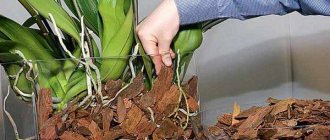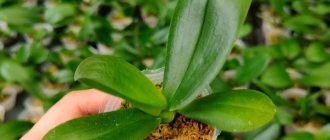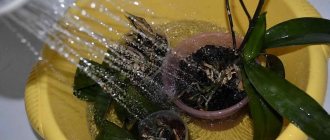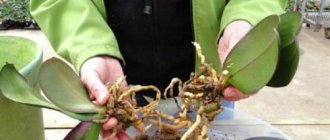Author of the article: Olga Viktorovna | Updated: 01/17/2022
Office chair Bureaucrat CH-296NX, Mesh, Fabric, black
3290 ₽ More details
Gaming keyboard Defender Metal Hunter, silver
790 ₽ More details
Fissman grill pans
A greenhouse for an orchid in some cases becomes a necessary measure for the continued existence of the flower. In this article we will look at why it is needed and how to make it yourself.
How to make a greenhouse for an orchid at home?
Orchidists keep the most demanding varieties in home florariums or orchidariums . mini-greenhouses in their homes to resuscitate damaged orchids.
This is done for the simple reason that most orchids come from the tropics, where they live in moist evergreen forests.
And the atmosphere of a human home is aggressive for them. Building a small greenhouse is quite simple, even from scrap materials.
With your own hands
The operation of a greenhouse is based on simple principles - heat radiation and heat exchange . Electromagnetic radiation, for example, from the sun or a lamp enters the greenhouse, where it is converted into heat, which is accumulated and retained by its walls. Due to the fact that the greenhouse is a closed structure , it maintains the required temperature and humidity.
The arrangement and size of the greenhouse depend on the goal you are pursuing and the result that is needed. So, you can build a greenhouse for resuscitation of one orchid from an ordinary plastic bottle . If you plan to keep a small collection of orchids in a greenhouse, you will need a larger structure: an aquarium or a terrarium cabinet.
A greenhouse can be made from a plastic bottle.
At home, greenhouses are built from scrap materials and even garbage. Any transparent container will do:
- plastic bottles;
- transparent confectionery boxes;
- transparent boxes;
- packages;
- oilcloth or stretch film.
The frame can be made of wire or wooden rods.
Preventive measures
Having decided to grow Phalaenopsis at home, it is important to consider all the subtleties of caring for it. In general, Orchids are capricious plants. But with proper care, they will grow and develop well, delighting their owner with abundant flowering.
Such indoor flowers react poorly to any deviations from comfortable living conditions. And the roots are the first to suffer from this. To avoid problems with rotting or drying of the roots, we grow the orchid correctly:
- It is necessary to organize a comfortable microclimate for the flower. The air temperature should not fall below 15°C in winter and 21°C in summer. Favorable humidity level is 50-60%.
- Organize a high-quality watering regime. Monitoring the condition of the soil will help to avoid problems with drying out and waterlogging of the substrate. Water the plant when it looks dry. Another option is to immerse the flower pot in warm water for 20-30 minutes.
- It is important to shade the flower from direct rays of the sun and protect it from the heat of heating devices in winter. The plant dies from their action.
- Regular fertilizing with nitrogen-containing compounds should be carried out, which can stimulate the root system to develop, especially if the young phalaenopsis is without roots. Fertilizers are applied along with watering no more than 2 times a month.
As the pet grows and develops at home, it should be transplanted every 3 years into a larger container.
When Phalaenopsis roots grow, they require space and a lot of air. Therefore, they will perceive the new place of detention favorably. It is also important that with replanting the air permeability of the soil also improves. And this is an important condition for the growth of a healthy orchid.
Design options
From a plastic bottle
5-6 or 10 liter water bottle is suitable . If you don't find one, you need to find one. 2 liter bottle may be suitable .
You need to make a hole in the bottle or cut off the top or bottom to place the orchid inside . You can secure the plant with wooden twigs, thick threads or women's tights.
From transparent plastic boxes
Having such a box with a lid (or without) in your household will greatly simplify your life. As a last resort, you can buy it. Then you won’t need to cut anything, just secure one or more plants inside and close with a lid.
Polycarbonate box
If you have a pair of straight hands and material, you can make a transparent box yourself. Polycarbonate is notable for the fact that it transmits light well, is easily cut into fragments , and, unlike glass, is lighter, warmer and stronger . In addition, such a greenhouse will completely suit you with its size and shape.
From a glass, volumetric container
If you have an old aquarium or terrarium lying around at home or in the garage, you can use it as a greenhouse. It would be great if the aquarium was illuminated, but more on that later.
Greenhouse from an aquarium.
Frame covered with film
A film or oilcloth is stretched over a solid wire skeleton . A simple design that can be easily assembled and disassembled as needed.
Plastic bag
The most extreme option is to place the potted plant in a transparent bag. Such a device will not require investment or time, and is fundamentally no worse than others.
Option 4: greenhouse for cuttings of orchids
For cuttings of orchids, two types of greenhouses are most often used:
| Type of cutting greenhouse | Description | Efficiency of cuttings |
| Cut plastic bottle or glass jar | A layer of damp moss is placed at the bottom of the cuttings, into which the cuttings are placed vertically. The top of the greenhouse is covered with cling film. | Low. The buds germinate slowly, and the cuttings are highly susceptible to mold. |
| Plastic food container | A layer of wet sphagnum is placed at the bottom of the container. The cuttings are laid horizontally on it and covered with a lid with ventilation holes. | Good. The buds are moistened along the entire length of the cutting, evenly illuminated and germinate faster. |
Thus, the best option for a cutting greenhouse is a wide and shallow plastic container. All its preparation for use comes down to making holes in the lid and preliminary disinfection of the container.
Landing
Priming. Layer structure organization
As a rule, sterilized coarse bark and sphagnum moss are placed in the greenhouse. If the design allows and there is sufficient volume, then you can put several layers of different materials.
A thin layer of small expanded clay or pebbles is placed on the bottom as drainage, then bark and sphagnum on top.
It is better to use dry moss , since you do not have to worry about maintaining its vital activity.
Important! All soil components must be disinfected. Calcine the expanded clay in the oven, the bark and sphagnum can be boiled or taken out in severe frost overnight.
Technology
When the base is prepared, you can start planting the plant. Since the reanimated orchid has no roots, there is no point in making a significant deepening:
- Make a small funnel in the moss to place the orchid in;
- Before this, soak the plant for 2 hours in epin, then powder the stump, where the roots once were, with heteroauxin or root ;
- Cover with moss. The moss should be moist but not wet;
- If necessary, the plant can be secured with wire, bamboo rods or other means.
If the design of the greenhouse does not allow you to put substrate in it, use perforated orchid pots. Periodically inspect the plant for rot or mold . The greenhouse should be located in a warm, well-lit place.
The greenhouse should be located in a well-lit place.
Option 3: greenhouse for growing orchid babies
Many gardeners who like to propagate orchids from children plant them immediately in separate cups. But sometimes the separated children are still too small to be planted in a separate container:
“For tiny children with 1-2 roots, even a plastic cup may be too spacious. If the volume of the substrate is much greater than the volume of the roots, young orchids will rot. Therefore, I recommend raising children in a common greenhouse school with a small volume of soil.”
Yu. Ivanova, orchid collector
Making such a greenhouse school is very simple. Any rectangular plastic container with a lid will do for this:
- Drainage holes are made at the bottom of the container.
- Holes are made in the lid for ventilation.
- A drainage layer of expanded clay, foam plastic or coarse bark is laid on the bottom.
- Children are placed on top, and their roots are sprinkled with substrate.
A layer of damp sphagnum moss is placed around the children, and the greenhouse is covered with a lid.
Reanimation
It is necessary to understand that since the orchid, for some reason, was left without roots , then resuscitation in a greenhouse is not suitable for it due to similar conditions.
Usually, orchids' roots rot from excess moisture. As a rule, this is due to insufficient light and is most often observed in the autumn-winter period. In order for a plant to carry out photosynthesis normally, it needs a certain amount of light.
This amount is different for all plants and may differ from one type of orchid to another. When even the minimum amount of light necessary for the photosynthesis process is received, the orchid absorbs moisture, carbon dioxide, and simply grows.
If there is not enough light, the plant goes into suspended animation , that is, it temporarily slows down its life processes, while the roots absorb a minimal amount of moisture. In the event that water continues to flow to the roots (you constantly water the plant), then the roots do not have time to absorb all the moisture , just as it does not have time to evaporate.
It turns out that the water stagnates, the walls of the root cells begin to collapse, the tissues are affected by microorganisms, and the process of rotting begins. The plant cannot neutralize this by the growth of new cells, as it simply sleeps.
Therefore, in order for the roots to start working, the plant needs a signal - bright diffused light for 12-14 hours a day.
As already mentioned, the greenhouse should be located next to a bright source of light. In this case, the temperature in the greenhouse should be maintained in the range of 22-28 °C.
Under such conditions, an optimal microclimate will be formed, similar to that in which orchids grow in the tropics. If all conditions coincide simultaneously, new root sprouts can be observed literally in the first 10-14 days.
Important! Ventilate the greenhouse daily. This must be done in order to saturate the atmosphere with carbon dioxide and prevent the appearance of mold. It is best to carry out the procedure in the evening. In summer, the greenhouse can be left open all night.
Try not to overheat or overcool the greenhouse. The temperature inside should not exceed 34 °C and fall below 22 °C. At higher temperatures, the plant overheats, experiences shock and, in an attempt to cool itself, begins to actively evaporate moisture, which is contraindicated for it. Since there are no roots, the orchid may simply wither. Hypothermia is fraught with the appearance of mold, rot, rotting of wounds and all parts of the plant.
Inspect your orchid periodically. If the slightest signs of rot appear, the plant must be dried and returned to the greenhouse, placed in such a way as to prevent a repetition of the mistake.
Be sure to inspect the orchid for rot.
When roots appear, begin spraying the plant with fertilizers at a concentration of ¼ of the concentration indicated on the package. The frequency of fertilizer application is once every 2-3 weeks. You can support the orchid with frequent (once every 3-4 days) iron supplements, as well as epin and zircon according to the instructions.
The resuscitation process can take quite a long time. On average, it is approximately 6 months . During this period, the plant grows roots (at least 4-5 cm in length) and is ready to be planted in a substrate for adult plants.
Use small, perforated pots . To prevent the orchid from falling out of the pot, it will need to be secured with wire, twigs, or tied to the pot with women's tights. Once the plant is secure in the pot, the garters can be removed.
Advice! If possible, leave the orchid in the greenhouse until it has gained a decent mass of roots.
Caring for a wilted plant and further prevention
What to do if the orchid's roots have rotted? Can rhizomes be reanimated? Yes, this can be done by caring for a plant that is in a greenhouse. To do this, you need to water the soil from time to time and monitor ventilation, which is best done in the dark. Oxygen begins to become saturated with carbon dioxide, which in turn has a beneficial effect on the reproduction of the root system. After two weeks, the first roots will appear, and when they reach 3-4 cm, the reanimated orchid can be transplanted into its usual conditions.
After finding out all the possible reasons why the orchid's roots are rotting and why it has lost many leaves, you need to learn about preventive measures that will prevent the resuscitation of orchids from being required so often. To do this, you need to ensure good lighting, air temperature and sufficient watering so that the roots do not rot due to waterlogging. If the orchid was damaged during the first propagation, growing roots also poses a problem for the entire development, which is undesirable to repeat.
To use one of the preventive methods, you first need to find out the cause of infections or other damage. There are several ways of varying degrees of impact to prevent such problems from appearing:
- Every person's medicine cabinet contains common antibiotics that can also be used for flowers, but they must be used very carefully.
- If only the leaves rot and are cut off, the flower feeds using the stem. You can get rid of a flower, but not the entire peduncle. After being saturated with nutrients, it will dry out and the orchid will get rid of it itself. But if the peduncle does not look the best from the very beginning, then it is better to remove it immediately.
- The planting container should be equipped with holes and well ventilated, and the soil should not be made too dense so that nothing interferes with air circulation.
- You need to water the plant not according to a schedule, but according to the color of the root system.
- It is necessary to take into account the lighting, especially in autumn and winter. During this period, it is advisable to reduce the application of fertilizers.
You may be interested in:
Orchid in hydrogel: planting, growing and care Orchid is a decorative flower that appeared on windowsills not so long ago. Among the various species, the most…Read more…
Saving an orchid without leaves
The opposite situation often happens: the root system is absolutely intact, but all the leaves have fallen off. Of course, it is much easier to notice in time when the leaves of an orchid turn yellow and take timely measures to save the flower before they fall off, but if this does happen, it is still possible to save an orchid without leaves (Figure 5).
Note: It is possible that the falling leaves were caused by a sunburn that the orchid received. Therefore, first of all, you need to come up with a new place to place the exotic, and only after that engage in its restoration.
To save a flower that has lost its leaves, you first need to pay attention to the root system. It is cleared of soil, all damaged areas are cut off and the wounds are sprinkled with disinfectant powder. After this, the entire plant must be thoroughly dried and treated with a fungicide.
Figure 5. If a crop has lost its leaves, but has a healthy root system, there is hope for its recovery
The orchid prepared in this way is planted in a pot and secured. At the initial stage, it is better to use moss rather than a special substrate, since the flower will take root in it much faster.
For the first time, the orchid is moved to a warm, well-lit place, but without direct sunlight. It is also undesirable for the flower to be exposed to drafts. In the first 10 days, the crop is not watered, and after that a gentle regime of moisture is used, and when the leaves grow, the orchid is again transplanted into a pot with a special substrate.











